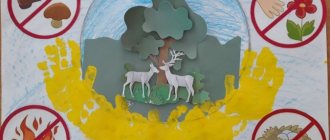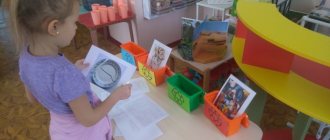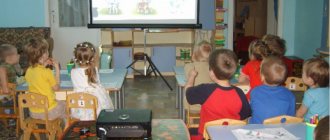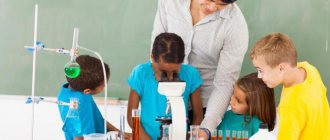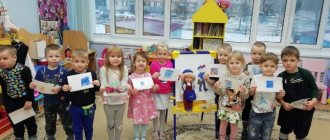Middle group. Junior preschool age. Children 4 - 5 years old
Environmental project "Ecolyats - preschool children" in the middle group Environmental project " Ecolyats - preschool children "
Middle group Justification of the problem.
The presence of global environmental environmental problems is a serious threat to all humanity in the modern world.
Today, the main task for people should be the preservation... Environmental social and educational project in the middle group (from 4 to 5 years old) “Eco-preschool children” Relevance of the Project One of the directions for the development of the state and the unification of a multinational society is the patriotic education of the younger generation. This is one of the priority areas in the Russian education system, contributing to the formation of...
Long-term project on environmental education for middle-aged children “Take care of nature, people”
MBDOU "Skalinsky kindergarten "Bell"
Long-term project on environmental education of preschool children “Take care of nature, People”
(Educational area: Cognitive development)
Middle preschool age
Educator: Yudkina V.S.
Rock
Type of project: long-term, group.
Relevance: Ecology is what surrounds each of us. Translated from Greek, the term “ ecology ”
means
“the science of the house” (oikos – house, homeland; logos – science, teaching, concept)
.
We must teach children to love and respect nature, to protect it, but first we ourselves must learn to love it. To learn to love and take care of your home, you need to get to know it. Environmental education of preschoolers
according to
the Federal State Educational Standard
is a continuous process of children’s development aimed at developing
an environmental
culture in them, which is expressed in the presence of:
· sustainable knowledge about nature and the relationships existing in it
respect for nature
· correct understanding of the concept of “healthy lifestyle”
· moral and environmentally valuable attitudes, behavioral skills
· emotional responsiveness to living nature
positive aesthetic sensations from admiring nature
· skills to understand the features of the surrounding world
People are facing an environmental disaster. It is important to convey to humanity that the cause of ecological imbalance is the consumer attitude of people towards the world around them. Man cannot exist without the natural environment, but nature can exist without man. It is important to convey to children from childhood that people must comply with the laws of nature and change their consumer attitude towards it to recognize its intrinsic value. It is in preschool age environmental positions , which help the child in the future to determine his attitude towards nature, empathy for it and taking active actions in solving most of the environmental problems that our world is now rich in. Absorbing like a sponge, a child receives knowledge from people close to him and develops, learns to behave correctly in nature, begins to realize what can be done and what cannot be done.
Environmental
problems are now becoming more urgent.
A preschool
institution performs an important function for society - it helps to reveal the beauty of nature to the younger generation, teach them to appreciate and protect it.
Therefore, from all of the above, we can conclude that our problem is relevant.
Target:
Formation of ecological culture of children; expansion of ideas about the nature of the native land, development of cognitive interest in environmental problems.
Tasks:
1. Study and analyze psychological and pedagogical literature on environmental education of children of middle preschool age.
2. Bring to an understanding of the intrinsic value of nature, its uniqueness and beauty;
3.
Help children form ideas about relationships and interdependence in nature;
4. Form an emotionally positive attitude towards the world around you;
5.
To form children’s ideas about the need to take care of the surrounding nature, plants, animals, and water bodies.
6. Teach children to reflect their acquired knowledge in stories and productive activities.
7. Invite children from other kindergarten groups to take part in the project.
Project implementation period:
one year
Project participants:
children of the middle group, their parents and teachers.
Predicted results:
Children;
— development of basic environmental knowledge and understanding of the intrinsic value of nature;
— development of positive interest in natural phenomena and objects;
- careful attitude towards nature.
Teachers:
— teachers’ acquisition of experience in educating preschoolers’ environmental culture, improving professional skills;
— improving the ecological culture of teachers, skills in organizing active forms of cooperation with the family.
Parents:
- enriching the level of environmental knowledge of parents, environmental culture of parents,
— understanding the need for environmental education of children;
— creation of a unified educational space for preschool educational institutions and families for the environmental education of preschool children.
Result:
— production of drawings and posters “Take care of nature!”
- performances by children defending their drawing-poster.
Project stages:
Stage 1: preparatory:
• Classes on environmental development: “What is ecology?”, “Migratory and wintering birds”, “Nature of our region”, “Wild animals of our region”, “Water, its importance for human life”, integrated classes on the topic “Take care of nature ", "In the garden or in the vegetable garden", etc.
• Conversations about the plants and animals of our region, about people who are defenders of nature, about the beauty of the forest around us, about the pollution of springs and reservoirs, about the rules of behavior in nature, about how each of us helps nature.
Conversation on the topic “What has autumn brought us?”, conversation on the topic “Medicinal herbs”, “My favorite flowers”, “How can we help the birds in winter?” etc.
• Excursion around the territory of the kindergarten “What interesting things did you find?” “Ecological trail in winter”, Excursion to an abandoned apple orchard.
· Observing nature and natural phenomena during walks.
• Role-playing games: “At a picnic”, “Fire in the forest”. “Fishing”, “Planted a vegetable garden”, “Zoo”, etc.
• Didactic games: “Name the plant”, “What kind of bird?”, “Where does the leaf come from?” “Where is whose house?”, “Get things in order!”, “What animals live in the forest”, “What shall we feed?”, etc.
• Examination of illustrations, paintings by artists, posters with environmental content.
• Learning poems, songs, proverbs, sayings, tongue twisters about nature.
• Reading fairy tales about nature conservation “Grey Riding Hood and the Red Wolf”, “Once Upon a Time There Was a River”, etc., stories about animals by M. Prishvin, V. Bianchi, etc.
• Watching cartoons.
• Watching videos on the topic “Ecology”.
• Conducting consultations for parents: “Man and Nature”, “Ecological Culture and Environmental Health” and others.
Stage 2: productive activity.
• Carrying out an environmental campaign to clean up the site together with teachers and children “Let’s make the site clean!”;
• Design of travel folders: “Take care of nature!”, “Rules of behavior in the forest”, “Our native land”
“Beware of poisonous plants”, “Let’s feed the birds in winter”, etc.
• Artistic and aesthetic development (productive activities: applique, drawing, modeling “Take care of nature!”, “Birds of your native land”, “My favorite animal”, “My favorite flower”, etc.
• Design of the short-term project “Vegetable garden on the windowsill”, caring for it.
• Conducting experiments with water, sand, air, soil.
• Making bird feeders, feeding birds in winter.
3
: Project presentation
· Ecological quiz “Visiting the forest”
· Conducting an open lesson on the topic “Wild Animals of Our Lands”, participation in the competition.
· Children's performance based on their drawing-poster.
The relevance of the development and implementation of a pedagogical project
From birth, children are surrounded by various phenomena of inanimate nature: on a summer day they see the sun and feel the warm wind; on a winter evening they look in surprise at the moon, the dark sky filled with stars, feel the frost pinching their cheeks... They collect stones, draw on the asphalt with chalk, play with sand and water - objects and phenomena of inanimate nature are part of their life activity, are objects of observation and play. This circumstance makes it possible to systematically and purposefully familiarize preschoolers with the phenomena of inanimate nature. Moreover, it is simply necessary.
In nature, everything is interconnected: plants, animals, soil, rivers, air, etc. are in inextricable unity - living nature cannot do without inanimate nature. The plant exists only because it penetrates the ground with its roots and absorbs moisture and nutrients from it, stretches its stem upward, and turns its leaves toward the sun, absorbing its light and heat. The plant needs air, moisture and warmth; in such favorable conditions it feels good: it grows, blooms, bears fruit and pleases the human eye.
The same can be said about animals: they, like plants, have vital needs, many of which can be satisfied only with the help of inanimate nature. Thus, animals, as part of living nature, have their own special relationships with inanimate nature.
Humans have an even stronger connection with inanimate nature than plants and animals. People need fresh air, for life and farming they need water, but not any water, only clean water - natural or specially purified. Humanity has reached such heights in the development of civilization because it has learned to use natural resources: extract coal, oil, ore, use clay and sand in construction, making household items...
Thus, all phenomena of inanimate nature that surround a preschooler are the subject of a unified system of environmental education.
Understanding the importance of search activity in the development of children’s cognitive activity and their intellectual abilities, I chose children’s experimentation as one of the types of activity. The proverb says: “Tell me and I’ll forget, show me and I’ll remember, let me try and I’ll understand.” Everything is assimilated firmly and for a long time when the child hears, sees and does it himself. This is the basis for the active introduction of children's experimentation into the practice of preschool institutions.
Project stages
I Preparatory stage
- The teacher determines the topic, goals and objectives, the content of the project, predicting the result.
- Discussion with parents of the project, clarification of the possibilities, funds necessary for the implementation of the project, determination of the content of the activities of all project participants.
II Main stage of the project implementation
- Implementation of a work plan for all types of activities with children.
- Interaction with parents to solve assigned problems.
- Creation of the club “The Unknown is Nearby”.
- Once a quarter, joint “meetings” of the club (parents and children) are held in the form of entertainment, games, activities, leisure, and consultations.
- Creation of an information space (information stand; design of a folder - moving).
- A selection of works of art and educational games on this topic.
III. The final stage
Diagnostics and summarizing work results.
- summing up the work on the project.
- survey of parents on the topic: “What has your child learned?”
- monitoring the quality of children’s mastery of material.
- open lesson - entertainment for parents “What we learned” (based on the results of the project).
- presentation of the project for teachers of preschool educational institutions, a message from the experience of working on the project.
Long-term plan for the club “The Unexplored is Nearby”
October
Parent meeting on the topic : Let's experiment, learn, create!
Contents : Informing parents that the main advantage of the experimentation method is that it gives children real ideas about the various aspects of the object being studied, about its relationships with other objects and with the environment. During the experiment, the child’s memory is enriched, his thought processes are activated, since the need constantly arises to perform operations of analysis and synthesis, comparison and classification, and generalization.
January
Consultation “Development of observation and curiosity of a preschool child through experimental games at home.” Contents: Informing parents on how to properly ensure the full environmental education of a child of middle preschool age. Continue to introduce games to study the properties of objects and inanimate phenomena that will be used by parents at home.
April
Open game-activity “Journey to the Sand Fairy.”
Forms of working with children
Based on conceptual approaches and taking into account the characteristics of children, we have developed and tested a series of developmental activities. The practical significance lies in the use of the developed material in various types and educational areas of children's activities.
The content of the project involves an integrated approach to the development of a child at the emotional, psychophysiological and intellectual levels through familiarity with nature in various types of work with children (for example, observations, work in nature, activities and holidays of an integrated nature, entertainment, experimental activities).
The choice of priority form of work with children depends on seasonality, children’s interest in the proposed activity, their age characteristics, and conditions.
Plan for working with children
September
Project development. Selection of method, literature.
October
Topic: “What kind of water?”
Purpose: To identify the properties of water: transparent, odorless, flows, some substances dissolve in it, has weight, has no color and odor.
Expected result : Children will learn the properties of water such as: transparent, flowing, is a solvent, has no color and odor, and has weight.
Topic: What's in the package?
Goal: Detect air in the surrounding space.
Expected result : Children learn that air occupies all the surrounding space.
November
Topic : Light - heavy.
Purpose: to introduce that objects can be light and heavy. Learn to determine the weight of objects and group objects by weight (light - heavy). Expected result : They will learn to determine the weight of objects and group objects by weight (light - heavy).
Topic: We are magicians.
Goal: Identify objects that interact with a magnet. Expected result : They will become familiar with the properties of a magnet and objects that interact with it.
December
Topic: How to warm your hands?
Goal: Identify the conditions under which objects can warm up (friction, movement; heat conservation). Expected result : They will learn to heat objects using friction, movement and identify the conditions for maintaining heat.
January
Topic: Glass, its qualities and properties.
Goal: Recognize objects made of glass; determine its qualities (surface structure, thickness, transparency) and properties (fragility, melting, thermal conductivity).
Expected result : Get acquainted with glass and its properties. Learn to identify its qualities.
February
Topic: Metal, its qualities and properties.
Goal: Recognize objects made of metal, determine its qualitative characteristics (surface structure, color) and properties (thermal conductivity, malleability, metallic luster).
Expected result : Get acquainted with metal and its properties. Learn to identify its qualities.
Topic: Magic mitten.
Goal : Find out the ability of a magnet to attract certain objects. Expected result : consolidate the properties of a magnet and identify with which objects it interacts.
March
Topic: Rubber, its qualities and properties. Goal: To recognize things made from rubber, to determine its qualities (surface structure, thickness) and properties (density, elasticity, elasticity). Expected result : Get acquainted with rubber and its properties. Learn to identify its qualities.
Topic: What do birds use to build their nests?
Purpose: To identify some features of the lifestyle of birds in the spring. Expected result : They will learn some features of the way of life of birds in the spring.
April
Topic: Plastic, its qualities and properties.
Goal: To recognize things made of plastic, to determine its qualities (surface structure, thickness, color) and properties (density, flexibility, melting, thermal conductivity). Expected result : Get acquainted with plastic and its properties. Learn to identify its qualities.
Topic: Water transparency.
Goal: To generalize “clean water is transparent”, “dirty water is opaque”. Expected result : Get acquainted with the property of water “transparency”, learn to identify clear water.
May
Topic: "Paper lumps."
Goal: To introduce children to a new property of paper - rolling. The teacher teaches children to make lumps of paper, and then use them as a collective applique. Expected result : They will become familiar with a new property of paper - rolling. The teacher teaches children to make lumps out of paper, and then from them into a collective applique.
Future perspective
Develop a project “The Unknown is Nearby” for children in the senior and preparatory groups.
Although the most significant thing in the mental development of a child occurs at the early age stage, it is necessary to purposefully engage in experimental activities at the next stages of the personal formation of children.
Continuing the further development of cognitive and creative activity through the involvement of preschoolers in research work, the teacher prepares children for a very difficult stage in their lives - the school years.
